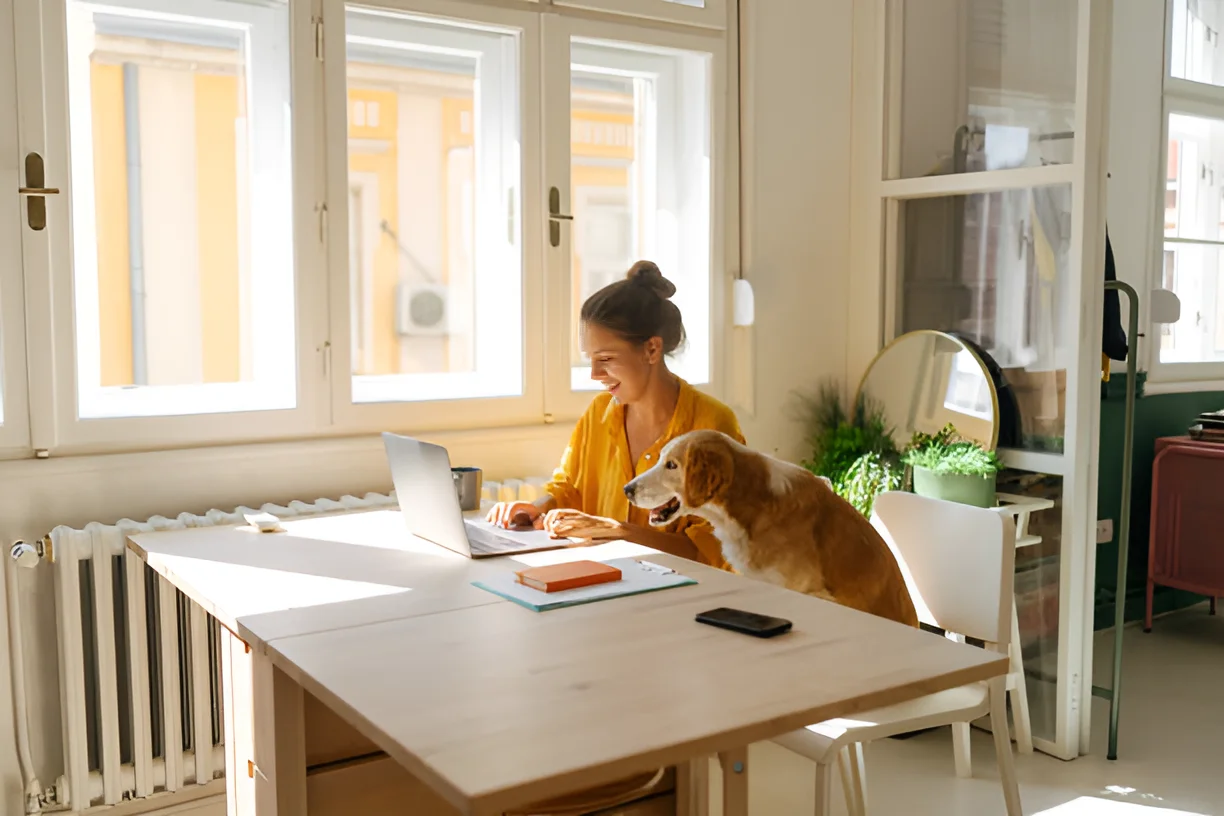Dogs can thrive in apartments as long as their exercise, mental stimulation, and social needs are met, regardless of the size of the living space. Understanding your dog’s specific requirements and providing a suitable environment is key to ensuring their happiness and well-being.
Living in an apartment doesn’t mean you can’t have a dog. Many dogs adapt well to apartment living, provided their needs are met. This comprehensive guide will explore how much space a dog needs in an apartment, the factors that influence their comfort, and tips for creating a dog-friendly environment in a smaller living space.
Factors Influencing Space Needs
Size and Breed of the Dog
The size and breed of your dog play a significant role in determining their space needs. Larger breeds generally require more room to move around, while smaller breeds can be more comfortable in limited spaces.
- Small Breeds: Breeds like Chihuahuas, Pomeranians, and Dachshunds are well-suited for apartment living due to their small size and lower space requirements.
- Medium Breeds: Breeds such as Beagles, Cocker Spaniels, and French Bulldogs can also adapt well to apartments if they receive adequate exercise and mental stimulation.
- Large Breeds: Larger breeds like Golden Retrievers, Labradors, and German Shepherds can live in apartments, but they need more exercise and space to stretch out.
Energy Levels
A dog’s energy level is another crucial factor. High-energy dogs need more physical activity and mental stimulation, which can be challenging in a small apartment.
- High-Energy Dogs: Breeds like Border Collies, Australian Shepherds, and Jack Russell Terriers require significant exercise and mental engagement. Regular outdoor activities are essential for these breeds.
- Low-Energy Dogs: Breeds such as Bulldogs, Basset Hounds, and Shih Tzus are more sedentary and can be content with shorter walks and indoor play.
Age and Health
The age and health of your dog also influence their space needs. Puppies and young dogs are more active and require more space to play, while older dogs may be less active and need a comfortable area to rest.
- Puppies: Puppies are energetic and curious, needing space to explore and play. Puppy-proofing your apartment and providing safe play areas is essential.
- Senior Dogs: Older dogs may have mobility issues and prefer a quiet, comfortable space to relax. Ensure they have easy access to their bed, food, and water.
Creating a Dog-Friendly Apartment
Designated Areas
Creating designated areas for your dog can help them feel more comfortable and secure in an apartment.
- Sleeping Area: Provide a cozy bed in a quiet corner where your dog can rest undisturbed. Ensure the bed is appropriately sized for your dog.
- Feeding Area: Set up a specific area for feeding with their food and water bowls. Keep this area clean and accessible.
- Play Area: Designate a space for play with toys and interactive games. Rotate toys regularly to keep your dog engaged.
Exercise and Mental Stimulation
Regular exercise and mental stimulation are crucial for a dog’s well-being, especially in an apartment setting.
- Daily Walks: Take your dog for daily walks to provide physical exercise and mental stimulation. Explore different routes to keep walks interesting.
- Indoor Play: Engage in indoor play sessions with toys, fetch, and tug-of-war. Use puzzle toys and treat-dispensing toys to challenge your dog’s mind.
- Dog Parks: Visit local dog parks to allow your dog to run off-leash and socialize with other dogs. This provides both physical exercise and social interaction.
Training and Socialization
Proper training and socialization are essential for a well-behaved dog in an apartment.
- Obedience Training: Teach basic commands such as sit, stay, come, and heel. Consistent training helps manage your dog’s behavior and ensures they are well-mannered.
- Socialization: Expose your dog to various environments, people, and other animals to build their confidence and reduce anxiety.
Managing Common Challenges
Noise and Barking
Noise and barking can be a concern in apartments, especially with close neighbors.
- Training: Train your dog to minimize barking by using commands and positive reinforcement. Address the root cause of barking, such as boredom or anxiety.
- White Noise: Use white noise machines or fans to mask outside noises that may trigger barking.
- Calming Aids: Consider using calming aids such as pheromone diffusers or anxiety wraps to help reduce stress and barking.
Potty Training
Potty training is crucial for apartment dogs, especially if you don’t have immediate access to outdoor spaces.
- Regular Breaks: Take your dog outside regularly for potty breaks, especially after meals, playtime, and naps.
- Indoor Solutions: Use indoor potty solutions such as pee pads or artificial grass patches for times when outdoor access is limited.
- Consistency: Be consistent with potty training routines and reward your dog for going in the designated area.
Space Optimization
Maximizing the available space in your apartment can help create a comfortable environment for your dog.
- Vertical Space: Utilize vertical space with shelves and perches for small dogs to climb and explore.
- Multi-Functional Furniture: Invest in multi-functional furniture such as storage benches or ottomans that double as dog beds.
- Decluttering: Keep your apartment clutter-free to provide more open space for your dog to move around.
Conclusion
Dogs can thrive in apartments as long as their exercise, mental stimulation, and social needs are met, regardless of the size of the living space. By understanding your dog’s specific requirements and creating a dog-friendly environment, you can ensure their happiness and well-being. Regular exercise, proper training, and thoughtful space optimization are key to making apartment living enjoyable for both you and your dog.
The photo featured below the post headline is Credit: AleksandarNakic/istockphoto
I hope you find this post helpful and informative. If Yes’ feel free to share it with your friends!
Frequently Asked Questions
Can large dogs live in apartments?
Yes, large dogs can live in apartments as long as they receive adequate exercise and mental stimulation. Regular walks, playtime, and visits to dog parks are essential for their well-being.
How often should I take my dog out for exercise?
Dogs should be taken out for exercise at least once or twice a day, depending on their energy levels and breed. High-energy dogs may require more frequent and longer exercise sessions.
What are some good indoor activities for dogs?
Good indoor activities for dogs include playing with toys, engaging in training exercises, using puzzle toys, and playing interactive games like fetch or hide-and-seek.
How can I reduce my dog’s barking in an apartment?
To reduce barking, address the root cause, use training techniques, provide mental stimulation, and consider calming aids. Consistency and positive reinforcement are key.
What are some space-saving tips for living with a dog in an apartment?
Utilize vertical space, invest in multi-functional furniture, and keep your apartment clutter-free to maximize available space for your dog.

